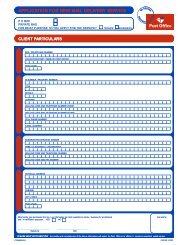new issues... - Virtual Post Office
new issues... - Virtual Post Office
new issues... - Virtual Post Office
You also want an ePaper? Increase the reach of your titles
YUMPU automatically turns print PDFs into web optimized ePapers that Google loves.
Flute<br />
In South Africa, traditional<br />
fl utes are made from natural<br />
materials like small animal<br />
horns, wood, hollow bones and<br />
river reeds. Some end-blown<br />
fl utes are open at both ends and<br />
the player produces a variety of<br />
notes by closing and opening the<br />
bottom end with one fi nger and<br />
selecting high or low pitches depending<br />
on how hard it is blown. Flutes serve a<br />
number of purposes, for example herd<br />
boys use them to signal to their cattle or<br />
to each other from a distance<br />
Xylophone<br />
Xylophones, also known as marimbas,<br />
are most highly developed in Mozambique,<br />
where they play an important<br />
cultural and social role. The mbila mutondo of the Venda is<br />
the only traditional marimba in South Africa. Although the<br />
instrument has been adapted by many South African cultures<br />
and has become popular over the years, the original Venda<br />
mbila is now quite rare.<br />
Rattles<br />
Rattles and shakers are used to create<br />
percussion in dancing. Rattles are either<br />
handheld or worn on the ankles as part<br />
of a dance costume. In South Africa, rattles were traditionally<br />
made from cocoons, fruit shells, goat skin or palm leaves tied<br />
up and fi lled with stones or seeds. Ankle rattles emphasise a<br />
dancer’s leg movements and add some rhythm to a dance.<br />
Bows<br />
Bows enjoyed widespread popularity in pre-colonial days,<br />
but many are no longer made or played. South African bows<br />
were traditionally made from natural materials. The stave is<br />
made from wood and the string from<br />
twisted fi bre, si<strong>new</strong>, hair or wire. Bows<br />
can be plucked with the fi ngers, struck<br />
with a light stick or grass stem or<br />
rubbed with a dry stick. Some bows are<br />
also activated by blowing.<br />
Reference:<br />
The Drumcafé’s Traditional Music of South Africa, Laurie<br />
Levine, Jacana Media (Pty) Ltd, 2005<br />
Technical information:<br />
Stamp issue date: 30 June 2011<br />
Layout and design: Hein Botha<br />
Stamp size: 38 x 29.07 mm<br />
Stamp sheet size: 210 x 78.14 mm<br />
Paper: Yellow Green Phosphor 102g/m2<br />
Gum: PVA gum<br />
Quantity printed: 40 000 sheets of 10 stamps<br />
Colour: CMYK<br />
Printing process: Offset Lithography<br />
Printed by: Cartor Security Printing, France<br />
9<br />
Setempe May-Aug 2011





